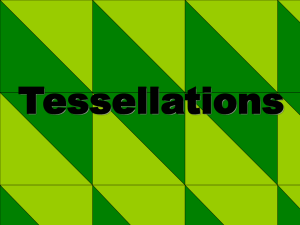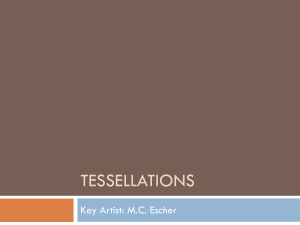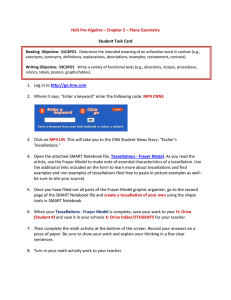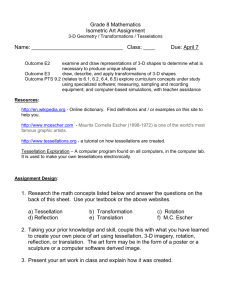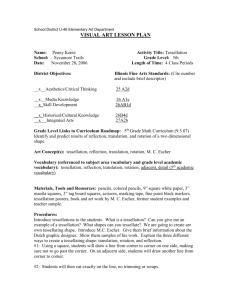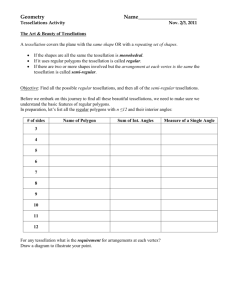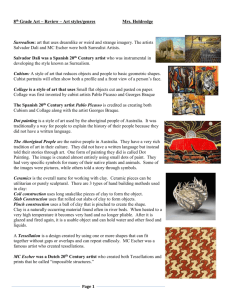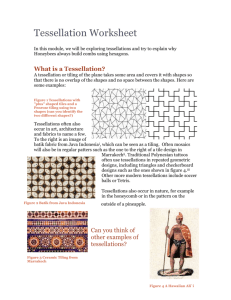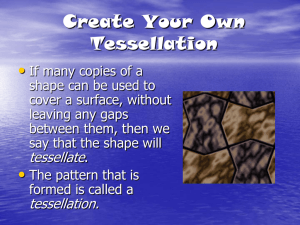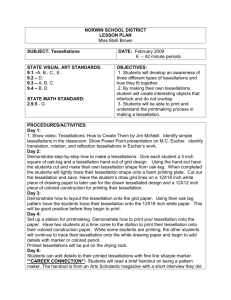Students will create and choreograph a dance focusing on the
advertisement
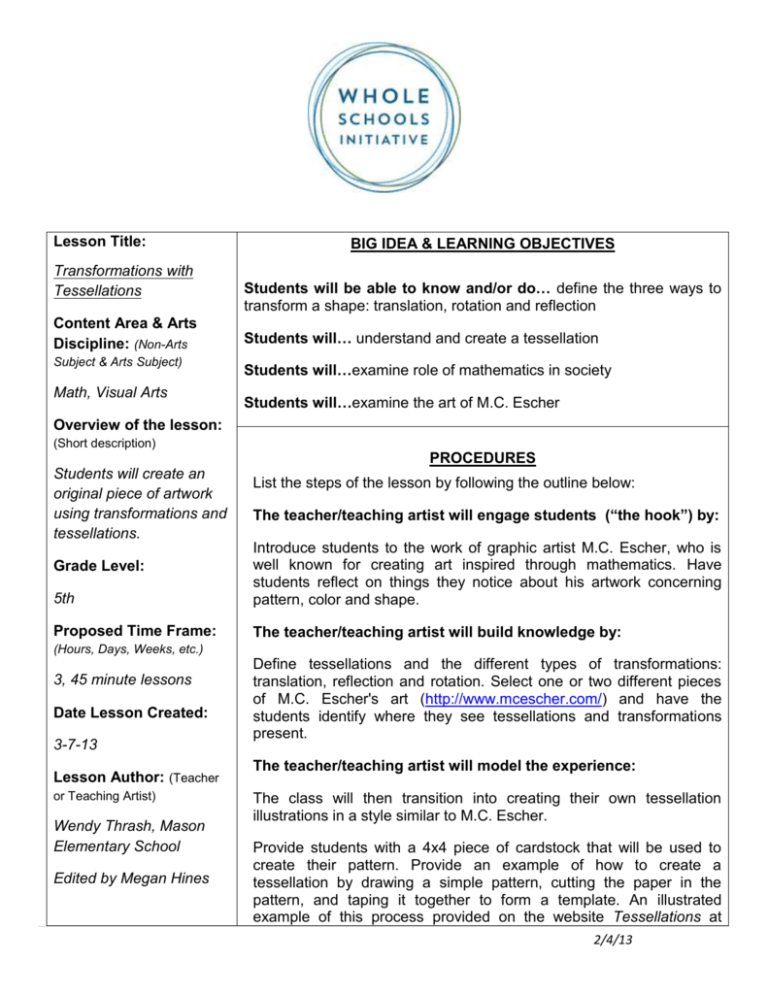
Lesson Title: Transformations with Tessellations Content Area & Arts Discipline: (Non-Arts Subject & Arts Subject) Math, Visual Arts BIG IDEA & LEARNING OBJECTIVES Students will be able to know and/or do… define the three ways to transform a shape: translation, rotation and reflection Students will… understand and create a tessellation Students will…examine role of mathematics in society Students will…examine the art of M.C. Escher Overview of the lesson: (Short description) PROCEDURES Students will create an original piece of artwork using transformations and tessellations. List the steps of the lesson by following the outline below: The teacher/teaching artist will engage students (“the hook”) by: 5th Introduce students to the work of graphic artist M.C. Escher, who is well known for creating art inspired through mathematics. Have students reflect on things they notice about his artwork concerning pattern, color and shape. Proposed Time Frame: The teacher/teaching artist will build knowledge by: Grade Level: (Hours, Days, Weeks, etc.) 3, 45 minute lessons Date Lesson Created: 3-7-13 Lesson Author: (Teacher or Teaching Artist) Wendy Thrash, Mason Elementary School Edited by Megan Hines Define tessellations and the different types of transformations: translation, reflection and rotation. Select one or two different pieces of M.C. Escher's art (http://www.mcescher.com/) and have the students identify where they see tessellations and transformations present. The teacher/teaching artist will model the experience: The class will then transition into creating their own tessellation illustrations in a style similar to M.C. Escher. Provide students with a 4x4 piece of cardstock that will be used to create their pattern. Provide an example of how to create a tessellation by drawing a simple pattern, cutting the paper in the pattern, and taping it together to form a template. An illustrated example of this process provided on the website Tessellations at 2/4/13 http://www.tessellations.org/methods-diy-papercut.shtml. Room Requirements & Arrangement: (Location of chairs, classroom or gym, etc.) The teacher/teaching artist will guide the practice with the students by: Classroom While students are brainstorming their tessellations, provide them feedback on how their pattern will fit together. Materials/Equipment: The students will apply understanding by: (Arts supplies, tech equipment, etc.) 9x12 drawing paper 4x4 card stock Pencils Scissors Tape Markers Pre-made examples Resources: (Additional books, website addresses, images, etc.) M.C. Escher artwork and biography http://www.mcescher.com/ Vocabulary: (Key words for both the non-arts and arts subjects) Tessellation Transformation Translation Rotation Reflection Students will then create their tessellations on a larger 9x12 piece of drawing paper, completing the pattern across the whole page. Students will then have the opportunity to add color to the tessellations to complete the drawing. The teacher/teaching artist will create opportunities for reflection (Closing) by: After the students have created their tessellation student will write on index cards the transformation they used with explanation. Students will write three or more sentences on how transformations and tessellations are used in society or nature. On a second card students will answer the following questions: What did you like? What did you learn? What would you do next? After everyone has finished have a group discussion where everyone gets ninety seconds to talk about their art work. The teacher/teaching artist will assess the students’ learning by: Successful use of translation, rotation, and reflection in a tessellation. Creativity and detail and neatness of coloring. Understanding of how transformations and tessellations are used in society and nature. STANDARDS & PRINCIPLES Please list the competency from the following: State Content Standards (i.e. CCSS, Mississippi Frameworks): Math Geometry 5.G Classify two-dimensional figures into categories based on their properties. 3. Understand that attributes belonging to a category of twodimensional figures also belong to all subcategories of that category. For example, all rectangles have four right angles and squares are rectangles, so all squares have four right angles. Arts Standards (i.e. MS Visual & Performing Arts Frameworks): 2/4/13 Visual Arts 3. Increase knowledge and use of various media, techniques, and processes in creating different effects in works of art. (CP) a. Demonstrate the ability to competently manipulate two-dimensional and three- dimensional media. b. Examine a variety of art works and identify materials, techniques, and processes used to create them. 4. Develop perceptual skills and use increased visual arts vocabulary to make judgments while creating and studying works of art. (CA) a. Use correct art vocabulary to study works of art through oral and written means. b. Reflect on the process of creating individual works of art. 5. Recognize critical processes (response, description, analysis, interpretation, and evaluation) used in the examination of works of art and design through reading, writing, and speaking. (CA) a. Identify effective use of form, media, and technique through oral and written analysis. Principles of Universal Design for Learning (at least one from each of the three guiding principles): Provide Multiple Means of Representation 1.1 Offer ways of customizing the display of information 2.1 Clarify vocabulary and symbols 2.5 Illustrate through multiple media 3.1 Activate or supply background knowledge 3.2. Highlight patterns, critical features, big ideas, and relationships 3.3 Guide information processing, visualization, and manipulation 3.4 Maximize transfer and generalization Provide Multiple Means of Action and Expression 4.1 Vary the methods for response and navigation Provide Multiple Means of Engagement 8.3 Foster collaboration and community 9.3 Develop self-assessment and reflection APPENDIX Extended Learning Activities: Student can use a color scheme to color their tessellation. chart out of the “What you would do next” questions. TIPS/FAQs: References: (i.e. Works cited, etc.) 2/4/13 Make a
